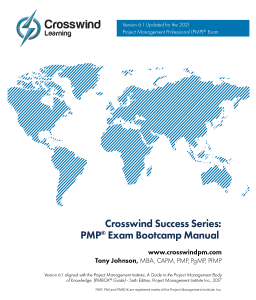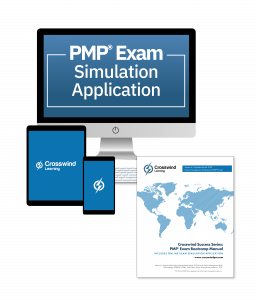Free PMP Terms and Definitions
Understanding common project management terms can be a challenge for all project managers. To help you understand those terms and definitions Crosswind Project Management has created a free to use glossary to help in your pmp training. In this page you will find the terms and definitions associated within the component areas of framework to get a better understanding of how this process works and relates to project management.
All projects are conducted within a surrounding environment. This environment has different aspects such as technical, social, political, and economic. Any of this can be a source of uncertainty for a project.
Sign Up for a daily free Tip of The Day!
| Term | Definition |
|---|---|
| Accept | A strategy for managing positive or negative risks where nothing is done until the risk occurs. |
| Ambiguity | The state of being unclear; not able to identify the cause of events or having many options to select from. |
| Assumption | A premise considered to be true without benefit of proof |
| Assumption Log | A project document that tracks assumptions related to the project. |
| Assumptions and Constraints Analysis | The evaluation of assumptions and constraints to ensure they are factored into the plan and related documents, and they are applied consistently. |
| Avoid | A risk response plan for negative risks where steps are taken to eliminate the risk so that it cannot occur. |
| Brainstorming | A group creativity session that encourages all members to spontaneously suggest ideas that will lead to a solution to a problem |
| Business Risk | A risk that is typically uninsurable because of doing business that could result in a profit or loss. |
| Complexity | The intricate arrangement of many parts or factors into a whole |
| Confirmation Bias | A cognitive bias that validates preexisting ideas, hypothesis, or beliefs. |
| Contingency | A possible event that could negatively impact the project and is typically neutralized by accessing the time or cost reserve established for that purpose |
| Contingency Plan | A risk response strategy that is pre-established and implemented if the risk occurs. |
| Contingency Reserve | Funds set aside for unforeseen events that can negatively effect the project |
| Decision Tree Analysis | A technique used to assess possible responses to a threat or opportunity in order to make the best decision; it involves diagramming the options and notating the expected monetary value (EMV) potential of each option |
| Effect-Based Risk Classification | An approach to analyzing bigger project risks that could impact project success. Categories includes scope, schedule, budget, and quality. |

Crosswind’s 35 Contact Hour PMP Exam Prep Course Bundle offers the best PMP certification training. This 4 day course is taught by author Tony Johnson will help you pass the PMP Exam the first time via the Crosswind Way!
| Term | Definition |
|---|---|
| Enhance | A risk response strategy for positive risks or opportunities that takes steps to improve the size or capacity of the risk event. |
| Escalate | A risk response strategy that addresses risks that are bigger than the project manager authority, or outside of the project where the risk is handed off to a person with the appropriate level to address it. |
| Expected Monetary Value (EMV) | A statistical technique, typically applied in decision tree analysis, used to determine the average outcome when contingent scenarios for future project risks must be considered |
| Exploit | A risk response strategy that involves ensuring the success of the project opportunity. |
| Insurable Risk | A risk (threat) where insurance can typically be purchased. Categories could include liability, personnel, and property. |
| Management Reserve | Funds set aside for unanticipated project work and excluded from the performance measurement baseline |
| Mitigate | A risk response strategy that takes steps to attempt to minimize the negative impact of the risk. |
| Monte Carlo Simulation | A process that simulates possible project schedule or cost outcomes; often used to estimate required reserves based on the scatter diagram or probability table that is typically the output of the process |
| Opportunity | A risk whose occurrence will result in a positive impact on the project |
| Overall Project Risk | The impact that uncertainty, including the cumulative effect of individual risks, has on the project; the exposure of stakeholders to the implications of variations in project outcome, both positive and negative. |
| Probability and Impact Matrix | An array used in qualitative risk management to prioritize risk, typically based on each risk’s probability of occurrence and potential impact |
| Qualitative Risk Analysis | A technique to establish the probability and impact of project risks. |
| Quantitative Risk Analysis | The process of numerically evaluating the impact of identified risks on the project |
| Reserve | Funds set aside for risks to the budget or schedule, for example management reserves or contingency reserves, as provided for in the project management plan |
| Reserve Analysis | An analysis technique used to identify the critical features and relationships of components in order to determine the amount of reserves realistically needed for the project with consideration of schedule duration, budget, and cost estimation |

Crosswind 2022 PMP Exam Bootcamp Manual
The PMP Exam Bootcamp Manual provides a foundation for the PMP Exam. This manual comes with a complete 200 question exam simulation application and 50/100 question ITTO exams created with over 1,400 ITTO questions in the data base.
| Term | Definition |
|---|---|
| Residual Risk | The remaining risk following the implementation of risk responses |
| Risk | An unscheduled, but possible, event that may have a positive or negative impact on the project if it occurs |
| Risk Acceptance | A risk response strategy that involves acknowledgement only of the risk; no planned response is formulated unless the risk occurs |
| Risk Appetite | The amount of uncertainty an organization or individual is willing to accept in anticipation of a reward. |
| Risk Audits | The evaluation of project risk responses to determine the effectiveness of the utilized approach to risk |
| Risk Avoidance | A risk response strategy that involves the elimination of the threat or protection of the project from the impact of the threat |
| Risk Breakdown Structure (RBS) | A representation of risks ranked by category |
| Risk Categorization | The organization of risks by source or other criteria to increase understanding of overall project risk |
| Risk Data Quality Assessment | An evaluation of risk-associated data to determine its quality |
| Risk Enhancement | A risk response strategy that increases the probability of occurrence or impact of an opportunity as a result of deliberate team action. |
| Risk Escalation | A risk response strategy that transfers ownership of the risk from the project team to a higher organizational level for more effectively management. |
| Risk Exploiting | A risk response strategy that ensures the occurrence of an opportunity as a result of deliberate team action. |
| Risk Exposure | The calculation that determines the impact to the schedule if risks are realized: multiply the probability of each risk occurring, expressed as a percentage, by the impact to the schedule if that risk is realized, expressed in days, and total the results |
| Risk Impact | What is at stake if the risk occurs. This is commonly, but not always, measured in dollars. |
| Risk Management Plan | The document, part of the project or program management plan, used to describe the manner in which risk management activities will be framed and executed |

Crosswind PMP Prep Bootcamp Manual and Premium PMP Exam Simulator Bundle 2022 Exam
With over 4,800 questions and 130 different test options available, The Crosswind PMP Exam Simulation Application is the most detailed Project Management Professional (PMP)® exam product on the market. Quizzes are available by knowledge area and exam domains as well as calculations, terminology, definitions. For added initiative, the exam allows you to randomize your questions and answers to keep every test unfamiliar and applicable. Attack the exam with confidence and competency. Success is yours when you work with Crosswind!
| Term | Definition |
|---|---|
| Risk Mitigation | A risk response strategy that involves the reduction of the threat or the probability that the risk will occur |
| Risk Owner | The person responsible for the monitoring of a risk and for the determination and implementation of an appropriate risk response strategy. |
| Risk Probability | The chance that a risk will occur during the project. |
| Risk Register | A document that lists each risk along with the results of its analysis and risk response planning |
| Risk Report | A project document that establishes the progressive development of risk management processes throughout the project, summarizes individual project risk information, and delineates the degree of overall project risk. |
| Risk Review | A meeting used to examine and document the effectiveness of risk responses in relation to identified, individual project risks and to overall project risk. |
| Risk Sharing | A risk responses strategy that allocates ownership of an opportunity from the project team to a third party who is best able to capture the benefits of that opportunity. |
| Risk Threshold | The degree of risk exposure that defines the upper limit of risk acceptance; risks whose level exceed the threshold must be addressed. |
| Risk Tolerance | The level of risk that an individual or organization is willing to permit; also known as risk utility |
| Risk Transference | A risk response strategy that involves shifting the impact of a threat, as well as accountability for the response, to a third party |
| Risk Workshop | A special meeting to identify project risks. It can include team members and any relevant stakeholders. |
| Risk-Adjusted Backlog | A backlog that can include product work to address any related threats and opportunities. |
| Risk-averse | Possessing a low desire or tolerance for risk |
| Risk-neutral | A middle ground between the risk taken and the benefit received |
| Secondary Risk | A risk that results from a risk response implementation |

Crosswind 2022 PMP Prep System
The Crosswind PMP Exam Prep Certification Study System provides everything you need in order to transform your studying into a successful testing experience. Obtain your PMP certification with ease using this comprehensive study system. Aligned with the 2022 PMP Exam Content Outline (ECO).
| Term | Definition |
|---|---|
| Sensitivity Analysis | A quantitative risk analysis and modeling technique used to identify those risks that have the greatest effect on the project |
| Share | A risk response strategy that involves the risk or opportunity being divided across multiple parties. |
| Source-Based Risk Classification | An approach to analyze risks based on their source. |
| Strengths, Weaknesses, Opportunities, and Threats (SWOT) Analysis | A risk analysis technique that considers the strengths, weaknesses, opportunities, and threats of the project to facilitate a more knowledgeable risk management analysis |
| Threat | A risk whose occurrence will result in a negative impact to the project |
| Transfer | A risk response strategy for negative risks or threats that assigns the risks to a third party. |
| Trigger Condition | An indicator that a risk event could occur |
| Uncertainty | Unknowns associated with tasks, issues, direction, or solutions associated with a project or product. |
| Uncertainty Domain | The performance domain associated with project risk and uncertainty. |
| Workaround | A response to a risk that was unplanned or that had an ineffective planned response |
